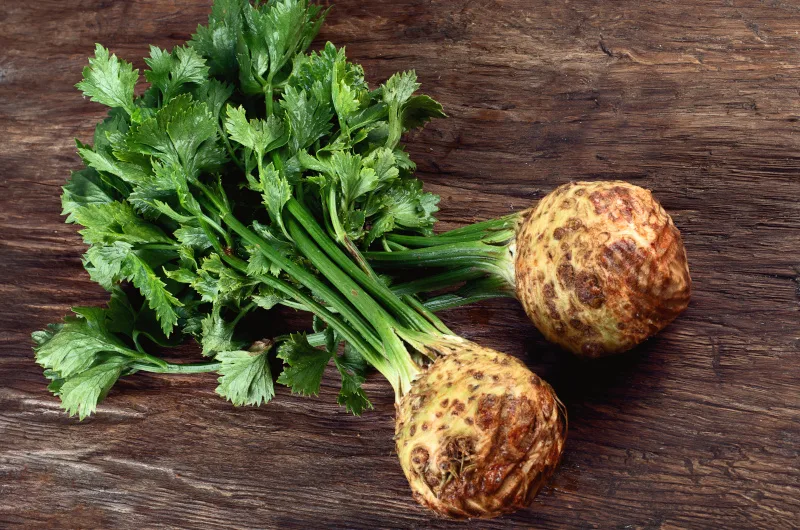How To Grow Celeriac
Celeriac, also known as celery root, is a versatile and flavourful vegetable which may be unfamiliar to many. Celeriac makes great mash, particularly when mixed with carrots and can also be made into celeriac steak – a vegan alternative with a great meaty texture. It’s also great in soups, or added into stews and casseroles. Although it may appear daunting to grow, with the right knowledge and care, you can grow celeriac in your own garden.
Choosing the Right Location To Grow Celeriac:
Celeriac thrives in cool, moist climates, making it an excellent choice for British gardens. Here are some key factors to consider when selecting a location:
- Sunlight: Celeriac prefers partial shade to full sun. Choose a spot in your garden that receives around 4-6 hours of sunlight daily.
- Soil: The soil should be well-drained, rich in organic matter, and slightly acidic (pH 6.0-7.0). Amend heavy clay soils with organic matter, such as compost or well-rotted manure, to improve drainage and fertility.
- Temperature: Celeriac prefers cool temperatures ranging from 10°C to 24°C (50°F to 75°F). Planting in early spring or late summer to early autumn is ideal.
Planting Celeriac:
Follow these steps to plant celeriac successfully:
- Seeds or Seedlings: You can start celeriac from seeds or purchase seedlings from a nursery. If starting from seeds, sow them indoors 10-12 weeks before the last expected frost date. Transplant the seedlings outdoors once the soil has warmed up.
- Spacing: Allow 30-45 centimetres (12-18 inches) between each plant and maintain 60-90 centimetres (24-36 inches) between rows.
- Planting Depth: Sow seeds or seedlings about 6 millimetres (1/4 inch) deep. Ensure the soil is moist but not waterlogged.
- Watering: Keep the soil consistently moist, providing approximately 2.5 centimetres (1 inch) of water per week. Avoid overwatering, as it can lead to root rot.
Care and Maintenance:
To ensure healthy growth and a bountiful harvest, consider the following care and maintenance tips for your celeriac plants:
- Mulching: Apply a layer of organic mulch around the plants to retain moisture, suppress weed growth, and maintain an even soil temperature.
- Fertilisation: Celeriac benefits from regular fertilisation. Apply a balanced, organic fertiliser every three to four weeks to provide necessary nutrients.
- Thinning and Weeding: Once the celeriac seedlings have grown to about 7 centimeters (3 inches) tall, thin them to leave the strongest plants about 30 centimetres (12 inches) apart. Regularly weed the area to prevent competition for nutrients.
- Blanching: About six to eight weeks before harvesting, blanch the celeriac plants by gradually mounding soil around the base of the stems. This process helps lighten the flavour and improves the appearance of the roots.
Harvesting and Storage:
Celeriac is typically ready for harvest 100-120 days after planting. Here’s how to harvest and store your celeriac:
- Harvest: Gently dig around the base of the plant, being careful not to damage the roots. Lift the celeriac out of the ground by lifting the rootball. Trim off the foliage, leaving about 2.5 centimetres (1 inch) above the crown.
- Storage: Celeriac can be stored for several months in a cool, dark place with high humidity, such as a root cellar or refrigerator. Remove any damaged or diseased roots before storage.
FAQ (Frequently Asked Questions):
Q: Can I grow celeriac in containers?
A: Yes, celeriac can be grown in containers. Choose a container with a minimum depth of 30 centimetres (12 inches) to accommodate the root development. Ensure the container has drainage holes and use a well-draining potting mix.
Q: How long does it take for celeriac seeds to germinate?
A: Celeriac seeds usually take around 14-21 days to germinate, depending on the temperature and conditions. Provide consistent moisture and keep the soil temperature around 21°C (70°F) for optimal germination.
Q: Are there any common pests or diseases that affect celeriac?
A: Celeriac can be susceptible to pests like carrot fly, slugs, and snails. Regularly monitor your plants for signs of infestation and take appropriate measures, such as applying organic pest control methods or physical barriers. Diseases such as celery leaf spot and root rot can also affect celeriac, so practicing good crop rotation and providing proper airflow can help prevent these issues.



